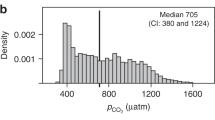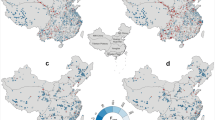Abstract
Carbon dioxide (CO2) evasion from streams and rivers to the atmosphere represents a substantial flux in the global carbon cycle1,2,3. The proportions of CO2 emitted from streams and rivers that come from terrestrially derived CO2 or from CO2 produced within freshwater ecosystems through aquatic metabolism are not well quantified. Here we estimated CO2 emissions from running waters in the contiguous United States, based on freshwater chemical and physical characteristics and modelled gas transfer velocities at 1463 United States Geological Survey monitoring sites. We then assessed CO2 production from aquatic metabolism, compiled from previously published measurements of net ecosystem production from 187 streams and rivers across the contiguous United States. We find that CO2 produced by aquatic metabolism contributes about 28% of CO2 evasion from streams and rivers with flows between 0.0001 and 19,000 m3 s−1. We mathematically modelled CO2 flux from groundwater into running waters along a stream–river continuum to evaluate the relationship between stream size and CO2 source. Terrestrially derived CO2 dominates emissions from small streams, and the percentage of CO2 emissions from aquatic metabolism increases with stream size. We suggest that the relative role of rivers as conduits for terrestrial CO2 efflux and as reactors mineralizing terrestrial organic carbon is a function of their size and connectivity with landscapes.
This is a preview of subscription content, access via your institution
Access options
Subscribe to this journal
Receive 12 print issues and online access
$259.00 per year
only $21.58 per issue
Buy this article
- Purchase on Springer Link
- Instant access to full article PDF
Prices may be subject to local taxes which are calculated during checkout



Similar content being viewed by others
References
Cole, J. J. et al. Plumbing the global carbon cycle: Integrating inland waters into the terrestrial carbon budget. Ecosystems 10, 171–184 (2007).
Battin, T. J. et al. The boundless carbon cycle. Nature Geosci. 2, 598–600 (2009).
Raymond, P. A. et al. Global carbon dioxide emissions from inland waters. Nature 503, 355–359 (2013).
Aufdenkampe, A. K. et al. Riverine coupling of biogeochemical cycles between land, oceans, and atmosphere. Front. Ecol. Environ. 9, 53–60 (2011).
Battin, T. J. et al. Biophysical controls on organic carbon fluxes in fluvial networks. Nature Geosci. 1, 95–100 (2008).
Öquist, M. G. et al. The full annual carbon balance of boreal forest is highly sensitive to precipitation. Environ. Sci. Technol. Lett. 1, 315–319 (2014).
Buffam, I. et al. Integrating aquatic and terrestrial components to construct a complete carbon budget for a north temperate lake district. Glob. Change Biol. 17, 1193–1211 (2011).
Turner, D. P., Jacobson, A. R., Ritts, W. D., Wang, W. L. & Nemani, R. A large proportion of North American net ecosystem production is offset by emissions from harvested products, river/stream evasion, and biomass burning. Glob. Change Biol. 19, 3516–3528 (2013).
Butman, D. & Raymond, P. A. Significant efflux of carbon dioxide from streams and rivers in the United States. Nature Geosci. 4, 839–842 (2011).
Lundin, E. J., Giesler, R., Persson, A., Thompson, M. S. & Karlsson, J. Integrating carbon emissions from lakes and streams in a subarctic catchment. J. Geophys. Res. Biogeosci. 118, 1200–1207 (2013).
Crawford, J. T. et al. CO2 and CH4 emissions from streams in a lake-rich landscape: Patterns, controls, and regional significance. Glob. Biogeochem. Cycles 28, 197–210 (2014).
Cole, J. J. & Caraco, N. F. Carbon in catchments: Connecting terrestrial carbon losses with aquatic metabolism. Mar. Freshwat. Res. 52, 101–110 (2001).
Duarte, C. M. & Prairie, Y. T. Prevalence of heterotrophy and atmospheric CO2 emissions from aquatic ecosystems. Ecosystems 8, 862–870 (2005).
Marcarelli, A. M., Baxter, C. V., Mineau, M. M. & Hall, R. O. Quantity and quality: Unifying food web and ecosystem perspectives on the role of resource subsidies in freshwaters. Ecology 92, 1215–1225 (2011).
Jones, J. B., Stanley, E. H. & Mulholland, P. J. Long-term decline in carbon dioxide supersaturation in rivers across the contiguous United States. Geophys. Res. Lett. 30, 1495 (2003).
Hannes, P. et al. Scales and drivers of temporal p CO 2 dynamics in an Alpine stream. J. Geophys. Res. Biogeosci. 119, 1078–1091 (2014).
Lynch, J. K., Beatty, C. M., Seidel, M. P., Jungst, L. J. & DeGrandpre, M. D. Controls on riverine CO2 over an annual cycle determined using direct, high temporal resolution p CO 2 measurements. J. Geophys. Res. 115, G03016 (2010).
Roberts, B. J., Mulholland, P. J. & Hill, W. R. Multiple scales of temporal variability in ecosystem metabolism rates: Results from 2 years of continuous monitoring in a forested headwater stream. Ecosystems 10, 588–606 (2007).
Jones, J. B. & Mulholland, P. J. Carbon dioxide variation in a hardwood forest stream: An integrative measure of whole catchment soil respiration. Ecosystems 1, 183–196 (1998).
Dodds, W. K. et al. Abiotic controls and temporal variability of river metabolism: Multiyear analyses of Mississippi and Chattahoochee River data. Freshwat. Sci. 32, 1073–1087 (2013).
Abril, G. et al. Amazon River carbon dioxide outgassing fuelled by wetlands. Nature 505, 395–398 (2014).
Ward, N. D. et al. Degradation of terrestrially derived macromolecules in the Amazon River. Nature Geosci. 6, 530–533 (2013).
Freeze, R. A. & Cherry, J. A. Groundwater (Prentice-Hall, 1979).
Vannote, R. L., Minshall, G. W., Cummins, K. W., Sedell, J. R. & Cushing, C. E. The river continuum concept. Can. J. Fish. Aquat. Sci. 37, 130–137 (1980).
Lapierre, J.-F., Guillemette, F., Berggren, M. & del Giorgio, P. A. Increases in terrestrially derived carbon stimulate organic carbon processing and CO2 emissions in boreal aquatic ecosystems. Nature Commun. 4, 2972 (2013).
Raymond, P. A. et al. Scaling the gas transfer velocity and hydraulic geometry in streams and small rivers. Limnol. Oceanogr. 2, 41–53 (2012).
Stackpoole, S. et al. in U. S. Geological Survey Professional Paper 1797: Baseline and Projected Future Carbon Storage and Greenhouse-Gas Fluxes in ecosystems of the Western United States Ch. 10 (US Geological Survey, 2012); http://pubs.usgs.gov/pp/1797
R Development Core Team, R: A Language and Environment for Statistical Computing (R Foundation for Statistical Computing, 2012); www.r-project.org
Harvey, J. W. & Wagner, B. J. in Streams and Ground Waters (eds Jones, J. B. & Mulholland, P. J.) 3–43 (Academic Press, 2000).
Hall, R. O. & Tank, J. L. Correcting whole-stream estimates of metabolism for groundwater input. Limnol. Oceanogr. 3, 222–229 (2005).
Greenway, H., Armstrong, W. & Colmer, T. D. Conditions lending to high CO2 (>5 kPa) in waterlogged-flooded soils and possible effects on root growth and metabolism. Ann. Bot. 98, 9–32 (2006).
Kruschke, J. K. Doing Bayesian Data Analysis: A Tutorial with R and BUGS (Elsevier, 2011).
Kruschke, J. K. Bayesian estimation supersedes the t test. J. Exp. Psychol. Gen. 142, 573–603 (2013).
Meredith, M. & Kruschke, J. BEST: Bayesian Estimation Supersedes the t-Test R package version 0.2.0 (R Foundation for Statistical Computing, 2013); http://cran.r-project.org/web/packages/BEST
Plummer, M. RJAGS: Bayesian Graphical Models Using MCMC R package version 3-10 (R Foundation for Statistical Computing, 2013); http://cran.r-project.org/web/packages/rjags
Acknowledgements
We thank P. Raymond for advice on CO2 emissions estimates. This work was supported by Kempestiftelserna.
Author information
Authors and Affiliations
Contributions
E.R.H. developed the ideas for this analysis and conceptual model in collaboration with J.Karlsson, R.O.H., R.A.S., J.Klaminder, M.R. and H.L. R.O.H. and E.R.H. derived the lateral inputs model and reviewed published metabolism estimates. D.B. provided CO2 and k600 estimates. E.R.H. analysed the data. E.R.H. wrote the paper with assistance from J.Karlsson, R.O.H., R.A.S., D.B., J.Klaminder, H.L. and M.R.
Corresponding author
Ethics declarations
Competing interests
The authors declare no competing financial interests.
Supplementary information
Supplementary Information
Supplementary Information (PDF 1743 kb)
Rights and permissions
About this article
Cite this article
Hotchkiss, E., Hall Jr, R., Sponseller, R. et al. Sources of and processes controlling CO2 emissions change with the size of streams and rivers. Nature Geosci 8, 696–699 (2015). https://doi.org/10.1038/ngeo2507
Received:
Accepted:
Published:
Issue Date:
DOI: https://doi.org/10.1038/ngeo2507
This article is cited by
-
User-focused evaluation of National Ecological Observatory Network streamflow estimates
Scientific Data (2023)
-
Substantial role of check dams in sediment trapping and carbon sequestration on the Chinese Loess Plateau
Communications Earth & Environment (2023)
-
River ecosystem metabolism and carbon biogeochemistry in a changing world
Nature (2023)
-
Integrating terrestrial and aquatic ecosystems to constrain estimates of land-atmosphere carbon exchange
Nature Communications (2023)
-
Pulse, Shunt and Storage: Hydrological Contraction Shapes Processing and Export of Particulate Organic Matter in River Networks
Ecosystems (2023)



